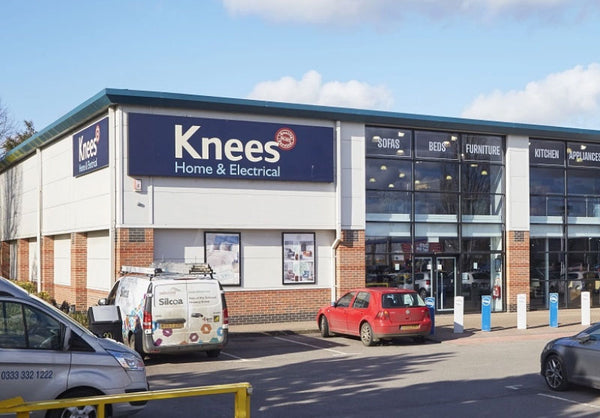Choosing the best heat pump tumble dryer
Heat pump tumble dryer buyers guide
You’re likely to have heard about heat pumps as one of the emerging technologies for reducing carbon emissions. The main focus has been on domestic heating applications, but there are many other ways to use the technology. Here at Knees Home & Electrical, we’ve looked in detail at all the questions you might want to ask when considering whether to invest in a heat pump tumble dryer.
So, what is a heat pump tumble dryer? The simple answer is that it is an appliance that dries your laundry in the same way as a conventional tumble dryer. However, there are significant differences in its energy use and recycling of heat. A heat pump cycle works by absorbing energy from a cooler area and releasing it into a warmer area. A heat pump dryer absorbs the water from your washing by passing hot air through the drum. The air then moves through an evaporator which extracts the water, depositing it in a reservoir. The hot air is restored to its optimum temperature and passed through the drum again, the process repeating itself until the drying cycle is complete.
What are the main advantages of a heat pump tumble dryer?
Cost
Although the initial cost may be a little more than a conventional dryer, the running costs are lower. This is because the dryer uses air that has already been warmed rather than supplying a constant flow of newly heated air. The result is significantly lower power consumption. It’s like re-boiling a hot kettle rather than emptying it, filling it with cold water and starting from scratch.
Environment
Alongside the cost saving is the environmental benefit. Compared to condenser or vented models, the best heat pump tumble dryer could use 50% less energy.
Gentler
Heat pump dryers generally operate at lower temperatures than other types which means they are kinder on your clothes and linens, keeping them in excellent condition for longer.
Flexibility
Because there is no need to plumb them in, you can install heat pump tumble dryers anywhere you like. There are no hoses or pipework tying you to a particular spot in a kitchen or utility room.
What are the disadvantages of a heat pump tumble dryer?
The answer is: very few. As we’ve said, they tend to cost more to buy, even though the price has fallen over recent years. However, as their use becomes more widespread, we expect to see prices fall to compete directly with conventional models.
If you choose a heat pump tumble dryer, you will have to accommodate a separate machine rather than have an all-in-one washer dryer, and, of course, you must empty the water reservoir every time you use it.
The only other noticeable drawback is that it takes longer to dry laundry. This is only an issue when you need something dried quickly. The rest of the time you can simply switch it on and forget it.
Things to Consider
The size of dryer is important and is determined by the needs of your household. How many people will it need to serve and how big is an average load likely to be? For one or two people, a capacity of up to five kilograms should be fine, while a household of three or four may need to go up to a seven kilogram drum and a household of more than four people will need something bigger, up to nine or 10kg.
Another thing to check is the energy rating. The best models should have an A+++ rating, which compares well with condenser dryers (usually only a B) and vented dryers (commonly a C).
Once you’ve checked the energy efficiency and decided which size will suit your requirements, you can think about the specific features you’d like your dryer to include.
Key Features
Integrated or freestanding
As we’ve seen, these dryers are very flexible, so there’s no requirement to have them in a specific location. However, you’ll probably want them near your washing machine. If you already have a built-in kitchen, you might prefer to have an integrated model which will be easy if you are replacing a vented or condenser machine but may require some room changes if there isn’t an existing space.
Timer
Many machines will come with a timer function allowing you to load the machine but set it to operate later in the day.
Wi-Fi
As the Internet of Things develops, you can now control many home appliances remotely using a smartphone and some heat pump tumble dryers have this facility.
Auto-sensing
This is a very useful feature that saves money and energy as well as protecting your laundry. It automatically senses when the washing is dry and switches off. However long you have set it to dry, it will run for only as long as necessary.
Lint filters
All dryers have lint filters: regularly emptying them will maintain the machine’s efficiency. You should look for filters that are easy to access, remove, and empty. The simplest to use will be just inside the door.
Electronic display
This can be helpful in tracking the progress through the cycle, especially if you don’t have auto-sensing. An electronic display can also give you other useful information about the dryer’s status, such as whether the filters are due for emptying.
Auto-programmes
Some dryers have special settings for particular types of laundry, such as an anti-creasing option that can eliminate much of the creasing that occurs in tumble drying. Other options could include extra-, cupboard-, hanger- and iron-dry.
Noise reduction
Although this doesn’t contribute to the dryer’s performance, it can be a welcome feature if the dryer is in a kitchen/diner.
Reverse tumbling
This feature alternates the direction of spin which can help prevent clothes and linens from tangling and deliver better drying results.
Brand and cost
The range of models on the market is very broad, depending on the brand, efficiency rating and number of features. Here at Knees, you’ll come across familiar household names including Bosch, Beko and Miele, and you’ll be able to find machines ranging in price from £320 to £2000. As with most appliances, it is usually worth paying as much as you can afford.



